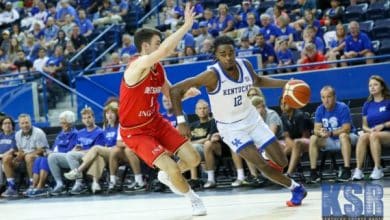
With their 13 victories to start the season, the Cavaliers are off to the best start in their history, and even the sixth best in the history of the league. And even if some successes have come down to little, and there is therefore an element of success, Donovan Mitchell and his teammates have always found the solutions.
How to explain it? It is first of all offensively that Cleveland seems to have turned a corner with the arrival of Kenny Atkinson in place of JB Bickerstaff. While the team was in 7th place for the most efficient defenses last year (112.1 points conceded per 100 possessions), it was on the other hand only 16th in offensive efficiency (114.7 points scored per 100 possessions). At the start of the season, the defense is in 6th place (109.9) but the attack has made a huge leap forward, to position itself in second position (120.9), just behind Boston!
Evan Mobley on the move to reduce spacing concerns
However, the squad has barely changed, but as Ben Taylor of Thinking Basketball explains, one of the changes in Ohio is the “inversion” in the use of Evan Mobley, who finds himself more often in a creative role, particularly when playing alongside Jarrett Allen.
As for Draymond Green at the Warriors, Scottie Barnes at the Raptors or Giannis Antetokounmpo at the Bucks, this use of an interior (weak shooter) in creation reduces the problems of “spacing” since, even without being an external threat, he always mobilizes a defender and attracts help in the event of an attack from the circle.
Even if JB Bickerstaff already did it last year, Kenny Atkinson also systematized the separation of the Garland/Allen and Mitchell/Mobley duos. As against the Bucks on November 4, the first tandem plays more over three long passages, while the second is over a rhythm of five shorter appearances.
A 3-point address that jumps
But the main difference, which explains the increase in offensive efficiency, is above all the 3-point skill of the Ohio squad, the best in the league at the start of the season, with 41.2% success. , compared to 36.7% last year. However, the number of outside attempts has changed very little (36.8 per match last year, 37.2 this season).
Except that Donovan Mitchell went from 36.8% success rate from afar to 40.7% at the start of the season, Isaac Okoro (from 39.1 to 48.5%) and Caris LeVert (from 32.5 to 45%) also having made a spectacular jump, even if the prize, given the volume, goes to Darius Garland, who finds the target at 44.9% from afar this season, compared to 37.1% last year.

Maybe the Cavs in general, and Darius Garland in particular, are a little in overdrive, and their skill will end up declining as the season goes on. However, there are notable adjustments to improve spacing and the quality of exterior shots. And one of those changes involves… cuts to the rim.
Multi-edged cuts
“This is a point we insist on” Kenny Atkinson recently explained. “When we talk about adjustments, what we did is that in the “old NBA”, everyone stayed wide, in place, with one guy playing the pick-and-roll. Now there are more movements, more cuts. I think we are in the Top 5 in terms of cups, in terms of the number of points per possession, we are also at that level. It's hard to defend when guys are moving and that's intentional. There are principles in our cuts. Because cutting opens spaces. The old way of thinking was to say that cutting obstructs space, but in fact it creates aspirations and corridors of penetration. So this is really a point that we really emphasize. »
But the “old NBA” was that of last year in Cleveland since we found this type of situation very often, the instructions then clearly being to always have one or two 3-point players on the weak side.
Paradigm change this season, the idea being to synchronize the cuts with the movements of the ball carrier, in order to fix certain defenders, particularly on the pick-and-roll. This action against the Warriors illustrates this well, Jonathan Kuminga not being able to both challenge Dean Wade's movement and Isaac Okoro's shot.
Especially since these cuts can also be used as a weak side screen…
A strategy which therefore sucks in defenders to offer more space on the weak side, but which also offers several passing solutions, often less risky, to the ball carrier, while allowing more presence on the offensive rebound. Even if, given the current address of the Cavs, this last point is little reflected in the figures.













